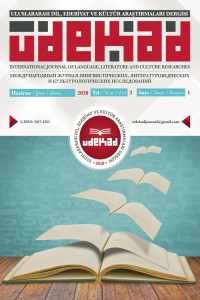YABANCI DİL OLARAK TÜRKÇE ÖĞRETİMİNDE KULLANILAN DİNLEME ETKİNLİKLERİNDE KRONOLOJİK SIRALAMANIN ÖNEMİ
Abstract
Dinleme, yabancı dil öğreniminin ilk basamak becerisidir ve bu becerinin geliştirilmesi dinleme metinleriyle sağlanmaktadır. Dinleme süreci; ders kitabı, radyo, televizyon ve bilgisayar gibi çeşitli araçlar vasıtasıyla gerçekleşebilir. Dinlenilen her şey birer metindir. Bu metinlerin de özellikle yabancı dil öğretiminde önemi büyüktür ve metinler dinleyenler için anlam ifade etmelidir. Dinlediğini anlamanın ölçme değerlendirmesi de dinlenilen metinlere ait etkinlik önermelerinin mantıklı bir sıralamada verilmesi ile gerçekleşebilir. Bu araştırmanın amacı, Gazi Üniversitesi Yabancılar için Türkçe (B2) ders kitabındaki dinleme metinlerine yönelik etkinliklerde yer alan önermelerin kronolojik sıralamasını tespit ederek bunun sonucunda meydana gelebilecek durumları betimlemektir. Araştırma bir durum çalışmasıdır. Veriler doküman incelemesi ile elde edilmiş ve içerik analizi yapılarak değerlendirilmiştir. Araştırma sonucunda ders kitabındaki dinleme metinlerine ait etkinliklerin yüzde kırk beşinin kronolojik açıdan sıralı olmadığı tespit edilmiştir. Sıralamaya dikkat edilmemesinin dinlemede ne gibi sorunlara yol açabileceği çeşitli araştırma sonuçları ile desteklenerek değerlendirilmiştir.
References
- Bingöl, MA., Çelik, B., Yildiz. N., Mart, CT. (2014). Listening comprehension difficulties encountered by students in second language learning class. Listening, 3.
- Bozorgian, H. (2012). Metacognitive instruction does improve listening comprehension. ISRN Education.
- Carney, N. (2018). Diagnosing L2 english learners' listening comprehension abilities with scripted and unscripted listening texts
- Goh, C. C. (2000). A cognitive perspective on language learners' listening comprehension problems. System, 28(1), 55-75.
- Hasan, A. S. (2000). Learners' perceptions of listening comprehension problems. Language Culture and Curriculum, 13(2), 137-153.
- Hoven, D. (1999). A model for listening and viewing comprehension in multimedia environments. Language Learning & Technology, 3(1), 88-103.
- https://www.telc.net/fileadmin/user_upload/Publikationen/Diller_iain_Avrupa_Ortak_oneriler_AEeraevesi.pdf
- Jones, L. C. (2003). Supporting listening comprehension and vocabulary acquisition with multimedia annotations: The students' voice. CALICO journal, 41-65.
- Nunan, D., & Miller, L. (1995). New ways in teaching listening. Alexandria, Va: Teachers of English to Speakers of Other Languages, Inc.
- Palmer, Erik. Teaching the Core Skills of Listening and Speaking, Association for Supervision & Curriculum Development, 2014. ProQuest Ebook Central, http://ebookcentral.proquest.com/lib/bogazici-ebooks/detail.action?docID=1681154.
- Renandya, W. A., & Farrell, T. S. (2010). ‘Teacher, the tape is too fast!’Extensive listening in ELT. ELT journal, 65(1), 52-59.
- Richards, J. C. (2001). The role of textbooks in a language program. Retrieved November, 12(2), 2008.
- Richards, J. C. (2005). Second thoughts on teaching listening. RELC Journal, 36(1), 85-92.
- Tyagi, B. (2013). Listening: An important skill and its various aspects. The Criterion An International Journal in English, 12, 1-8.
- Underwood, M. (1989). Teaching listening. London;New York;: Longman.
- Vandergrift, L. (1999). Facilitating second language listening comprehension: Acquiring successful strategies. ELT Journal, Volume 53, Issue 3, 168-176.
- Yagang, F. (1993, January). Listening: Problems and solutions. In English Teaching Forum (Vol. 31, No. 2, pp. 16-19). Teacher Development, Making the Right Movies.
- Yıldırım, A., & Şimşek, H. (2013). Sosyal Bilimlerde Nitel Araştırma Yöntemleri. Ankara: Seçkin Yayınevi.
Abstract
References
- Bingöl, MA., Çelik, B., Yildiz. N., Mart, CT. (2014). Listening comprehension difficulties encountered by students in second language learning class. Listening, 3.
- Bozorgian, H. (2012). Metacognitive instruction does improve listening comprehension. ISRN Education.
- Carney, N. (2018). Diagnosing L2 english learners' listening comprehension abilities with scripted and unscripted listening texts
- Goh, C. C. (2000). A cognitive perspective on language learners' listening comprehension problems. System, 28(1), 55-75.
- Hasan, A. S. (2000). Learners' perceptions of listening comprehension problems. Language Culture and Curriculum, 13(2), 137-153.
- Hoven, D. (1999). A model for listening and viewing comprehension in multimedia environments. Language Learning & Technology, 3(1), 88-103.
- https://www.telc.net/fileadmin/user_upload/Publikationen/Diller_iain_Avrupa_Ortak_oneriler_AEeraevesi.pdf
- Jones, L. C. (2003). Supporting listening comprehension and vocabulary acquisition with multimedia annotations: The students' voice. CALICO journal, 41-65.
- Nunan, D., & Miller, L. (1995). New ways in teaching listening. Alexandria, Va: Teachers of English to Speakers of Other Languages, Inc.
- Palmer, Erik. Teaching the Core Skills of Listening and Speaking, Association for Supervision & Curriculum Development, 2014. ProQuest Ebook Central, http://ebookcentral.proquest.com/lib/bogazici-ebooks/detail.action?docID=1681154.
- Renandya, W. A., & Farrell, T. S. (2010). ‘Teacher, the tape is too fast!’Extensive listening in ELT. ELT journal, 65(1), 52-59.
- Richards, J. C. (2001). The role of textbooks in a language program. Retrieved November, 12(2), 2008.
- Richards, J. C. (2005). Second thoughts on teaching listening. RELC Journal, 36(1), 85-92.
- Tyagi, B. (2013). Listening: An important skill and its various aspects. The Criterion An International Journal in English, 12, 1-8.
- Underwood, M. (1989). Teaching listening. London;New York;: Longman.
- Vandergrift, L. (1999). Facilitating second language listening comprehension: Acquiring successful strategies. ELT Journal, Volume 53, Issue 3, 168-176.
- Yagang, F. (1993, January). Listening: Problems and solutions. In English Teaching Forum (Vol. 31, No. 2, pp. 16-19). Teacher Development, Making the Right Movies.
- Yıldırım, A., & Şimşek, H. (2013). Sosyal Bilimlerde Nitel Araştırma Yöntemleri. Ankara: Seçkin Yayınevi.
Details
| Primary Language | Turkish |
|---|---|
| Subjects | Language Studies |
| Journal Section | Research Articles |
| Authors | |
| Publication Date | June 30, 2020 |
| Submission Date | March 23, 2020 |
| Acceptance Date | June 15, 2020 |
| Published in Issue | Year 2020 Volume: 3 Issue: 1 |
* It is important for our referees to enter their fields of expertise in detail in terms of assigning referees in the process.
* The articles sent to our journal can only be withdrawn by giving reasons during the preliminary evaluation process. It is not possible to withdraw the articles that have started the evaluation process. Thank you for your understanding and we wish you good work.


